Path Spread
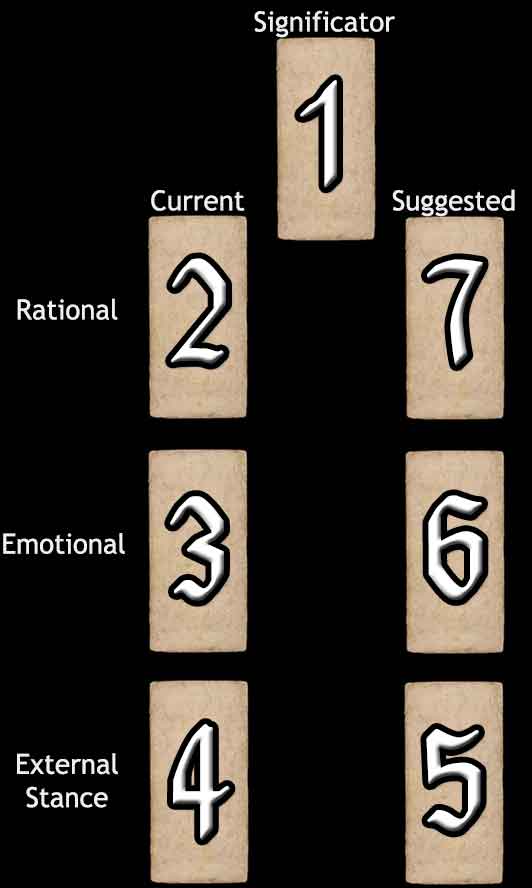
Difficulty: Easy
For the Path reading, one asks for suggestions how to behave properly to achieve a desired result. The Current column represents how the reader has been acting, and the Suggestedcolumn suggests how they should act to achieve a certain goal. The chart-like spread uses the standard three levels: Rational, Emotional, and External Stance (how one projects oneself outwardly). When comparing the Current and Suggested cards, the most important thing is to notice the differences between the two cards. It is these differences which hint at the behaviours that should be altered.
Card #1 is the significator, the card which should reflect the nature of the query and/or the desired outcome.
Card #2 shows the way the reader is and has been thinking. Card #7 suggests how to change the way one thinks to serve themselves better.
Card #3 suggests the reader's emotional attitude. Though it may seem difficult to manipulate one's own emotions, it can be done if one puts their mind to it. For example, acting a certain way such as smiling intently for a few minutes will lead the emotions to follow. When a person tries this, as silly as the exercise seems, they find this to evoke the emotion of happiness. For this reading, one should try to make themselves feel the way that Card #6 suggests.
External Stance means how one acts outwardly, how they hope others see them. Card #4 is about how the reader has been acting, while #5 indicates how they should act outwardly, for other people's sake. It is the differences between these cards that hint at what behaviour patterns should be altered.
Your Path Reading
Current |
The Significator 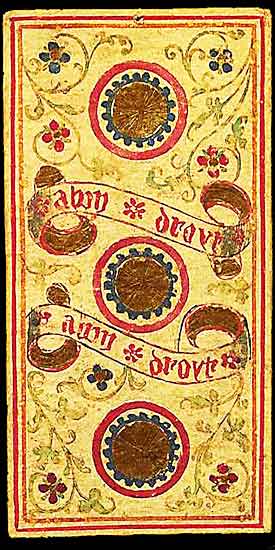 Three of Coins |
Suggested |
|
Thought |
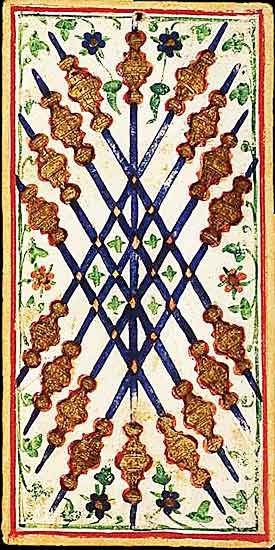 Nine of Staves |
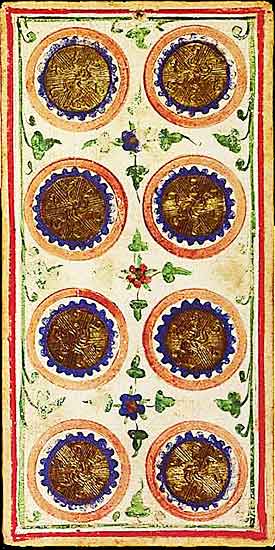 Eight of Coins |
|
Emotion |
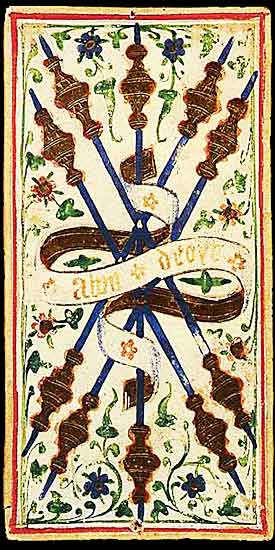 Five of Staves |
 Seven of Coins |
|
External Stance |
 Knave of Cups |
 Knight of Cups |

The Significator
Three of Coins
The Three of Coins symbolises collaboration, craftsmanship, and the value of teamwork. It represents working together to achieve a common goal, emphasising the importance of skill, effort, and recognition of individual contributions to a larger project.
Symbolism: The row of coins emphasises teamwork and synergy. The design suggests that when different talents and skills come together, they create something greater than the sum of their parts.
In Relationships: Collaboration and teamwork. The Three of Coins encourages building together, sharing responsibilities, and valuing each other's contributions.
In Work: A time to work with others towards a shared goal. The Three of Coins suggests that your efforts will be recognised, and teamwork leads to success.
Spiritually: Spiritual collaboration and mentorship. The Three of Coins may indicate working with others on a shared spiritual path, learning from collective wisdom.
When ill-dignified: Lack of cooperation, poor teamwork, or failure to appreciate the value of others' contributions. The Three of Coins warns against working in isolation or undervaluing collaboration.

Current Thoughts
Nine of Staves
The Nine of Staves represents resilience, endurance, and standing firm against adversity. It symbolises the strength to keep going despite challenges or setbacks.
Symbolism: The nine staves crossing evoke the image of a protective barrier. The design reflects both endurance and vigilance, as each staff represents a test that has been overcome, yet the gaps remind you to stay aware. The pale tan background reinforces the card's quiet strength and perseverance.
In Relationships: Endurance and commitment through difficult times. The Nine of Staves suggests that, despite obstacles or struggles, you have the strength to maintain and protect the relationship.
In Work: Perseverance and resilience in your professional journey. This card suggests you may be nearing the end of a difficult period and are strong enough to push through.
Spiritually: The Nine of Staves reflects inner strength and resilience in your spiritual journey. You may face trials, but you possess the endurance to stay true to your path.
When ill-dignified: Exhaustion, defensiveness, or being overwhelmed. You may feel the burden of too much resistance, and it's time to evaluate whether you're pushing yourself too hard.

Suggested Thoughts
Eight of Coins
The Eight of Coins symbolises hard work, dedication, and mastery. It speaks to the process of honing a skill or craft and emphasises the value of diligence and perseverance. This card encourages you to commit to your goals and take pride in your work.
Symbolism: The structured arrangement of the eight coins highlights precision, effort, and attention to detail. The ordered design represents a methodical approach to mastery and improvement.
In Relationships: Dedication to growing and improving a relationship. The Eight of Coins suggests putting in the effort to refine communication or deepen emotional connection.
In Work: Mastery and skill development in your professional life. This card emphasises focusing on your craft and making steady progress.
Spiritually: A time of deepening your spiritual practices and refining your beliefs. The Eight of Coins invites you to commit to your spiritual journey with consistency.
When ill-dignified: Lack of progress, poor workmanship, or burnout. The Eight of Coins warns against neglecting the effort required for success or losing focus.

Current Emotions
Five of Staves
The Five of Staves represents conflict, competition, and challenge. It symbolises the tension that arises when different forces or perspectives clash, but also the opportunity for growth through these struggles.
Symbolism: The five staffs crossing at various angles evoke discord, but the composition remains visually balanced. This dynamic tension suggests the conflict is not necessarily destructive, but a part of the process of growth and resolution. The flowers in the background underscore that this challenge is a natural, even necessary part of the journey.
In Relationships: Tension or conflict may arise, but this card suggests that healthy competition or differing viewpoints can lead to growth if managed properly.
In Work: Competition, challenges, or rivalry may be present. The Five of Staves urges you to stay focused and resilient, as this conflict can sharpen your skills and propel you forward.
Spiritually: Conflicts or challenges may arise, but they are opportunities to refine your beliefs and strengthen your character.
When ill-dignified: Escalating conflict or unnecessary competition. This could indicate that the struggle is becoming unproductive, leading to frustration or exhaustion.

Suggested Emotions
Seven of Coins
The Seven of Coins represents patience, investment, and assessment. It signifies a time to step back and evaluate the progress of your efforts. This card emphasises the importance of patience and the need to wait for the fruits of your labour to manifest.
Symbolism: The irregular arrangement of the seven coins suggests growth, progress, and the anticipation of results. Their grouping represents the natural rhythm of growth, with some efforts taking longer to bear fruit than others.
In Relationships: Reflecting on the progress of a relationship and taking stock of where things are headed. The Seven of Coins encourages patience and careful assessment before making major decisions.
In Work: Evaluating your career progress and investments. This card advises you to assess the returns of your efforts, as growth may be gradual.
Spiritually: A time of spiritual assessment, where you evaluate your progress on your path. The Seven of Coins encourages patience and trust in the process.
When ill-dignified: Impatience, frustration, or lack of faith. The Seven of Coins warns against rushing or abandoning your efforts prematurely.

Current External Stance
Knave of Cups
The Knave of Cups represents new emotional beginnings, curiosity, and intuition. It signifies the start of a new emotional journey, often marked by creativity, exploration, and open-heartedness.
Symbolism: The youthful figure holding a cup symbolises emotional openness and the willingness to explore new feelings and ideas. The vibrant green background contrasts with the figure's more muted robes, indicating that while this journey is new, it is rooted in emotional understanding.
In Relationships: A new romantic adventure, or the beginning of emotional exploration. This card signals fresh beginnings and open-hearted communication.
In Work: Creative opportunities or a new phase in your professional life. The Knave of Cups suggests following your intuition and embracing new emotional connections in your work.
Spiritually: A time of exploration and discovery. This card invites you to listen to your inner voice and follow your emotional intuition on your spiritual journey.
When ill-dignified: Emotional immaturity, unrealistic expectations, or a lack of direction. The Knave of Cups warns against rushing into things without considering the consequences.

Suggested External Stance
Knight of Cups
The Knight of Cups represents emotional pursuit, idealism, and romanticism. It speaks to the pursuit of dreams, following one's heart, and embarking on emotional quests with passion and dedication.
Symbolism: The knight on horseback, holding a cup, exudes an energy of romantic idealism and emotional drive. The pale horse's steady gait and the knight's confident posture suggest a balance between passion and grace.
In Relationships: Pursuing romance with enthusiasm and idealism. The Knight of Cups suggests a time of emotional pursuit, whether the beginning of a romance or a passionate phase in an existing relationship.
In Work: A pursuit of creative or emotional fulfilment. This card represents following your heart and idealism in professional endeavours.
Spiritually: The quest for spiritual or emotional fulfilment. The Knight of Cups invites you to pursue your highest ideals and trust your intuition on your spiritual journey.
When ill-dignified: Impulsiveness, emotional highs and lows, or unrealistic expectations. The Knight of Cups warns against becoming too idealistic or pursuing unrealistic goals without grounding.